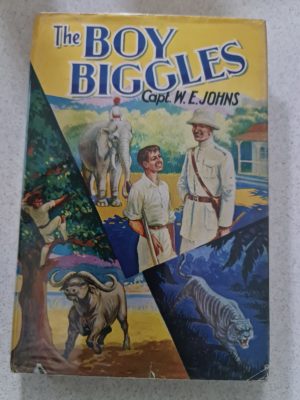Preface
The Happy Return (published 1937) is a Horatio Hornblower novel written by C. S. Forester. It is the sixth book in the series chronologically, but the first by order of publication.
June 1808, somewhere west of Nicaragua, a site suitable for spectacular sea battles. The Admiralty has ordered Captain Horatio Hornblower, now in command of the thirty-six-gun HMS Lydia, to form an alliance against the Spanish colonial government with an insane Spanish landowner; to find a water route across the Central American isthmus; and “to take, sink, burn or destroy” the fifty-gun Spanish ship of the line Natividad. A daunting enough set of orders, even if the married captain were not distracted by the passenger he is obliged to take on in Panama: Lady Barbara Wellesley.
https://www.goodreads.com/book/show/1466310.The_Happy_Return
Series Preface
A prolific author whose career spanned over forty years, C. S. Forester wrote action and adventure novels characterised by historical detail and unpretentious language. The British author was an outstanding storyteller who wrote highly cinematic fiction, and many of his books were adapted for film, including The African Queen (1935). His careful research and absorbing plots made him one of the top producers of popular fiction in English in the mid-twentieth century.
Works in Biographical and Historical Context
Birth in Egypt, C. S. Forester was born Cecil Lewis Troughton Smith in Cairo on August 27, 1899, the son of George Smith, an official in the Egyptian Ministry of Education, and his wife, Sarah (née Troughton). His mother returned home to England with Forester and his four older siblings so they could be educated there. From early on, he read voraciously, a book a day or more. He also developed a precocious interest in naval battles and military strategy.
Effects of War
In secondary school during World War I, Forester attended Officers’ Training Corps but was disqualified for military service due to a heart condition. World War I was caused by territorial tensions and entangling alliances that were spun into action by the assassination of Archduke Franz Ferdinand, the heir to the throne of the Austro-Hungarian Empire. The war soon engulfed nearly the whole of Europe, resulting in massive loss of life for soldiers and civilians alike. Nearly a million British soldiers alone were killed, wiping out much of a generation of young men.
In August 1918, bereft of friends lost in the war, which was nearing its end, Forester went on a solitary four-week camping trip. During the trip he came to terms with his rejection for military service and decided to enter medical school; however, he turned out to have a profound ineptitude for anatomy. In 1921, he adopted the pen name Cecil Scott Forester and embarked on a career as an author.
Two Books a Year
Forester wrote his first novel in a fortnight at the astonishing rate of six thousand words a day, had it typed, and sent it off to a publishing house. After four rejections, Forester gave up on the manuscript and started another. This time he injected an element of discipline into his efforts, slashing his daily production by two-thirds. By his own admission, he had not yet mastered the art of fully developing his ideas prior to commencing work. Forester would later disparage the second novel as “very bad.” Nevertheless, The Paid Piper (1924) – (and is an excellent film – The Pied Piper (1942)) would later become his third published book.
Forester’s third literary effort, A Pawn among Kings (1924), about Napoléon Bonaparte’s Russian campaign, was his first published book. Before it appeared, its publisher commissioned Forester to write a biography of Napoléon for an advance of twenty-five pounds, the first money he had earned as a writer. He subsequently wrote the biography Josephine, Napoleon’s Empress (1925). He would later consider this phase of his career as hackwork, and his earnings were less than he had anticipated. To ensure a subsistence income, he estimated, he needed to produce at least two books a year. He supplemented his income with more biographies and articles for trade periodicals for goldsmiths, pawnbrokers, and bus drivers.
Improved Literary Status
The thriller Payment Deferred (1926) began to establish Forester’s reputation. The novel, about a bank clerk who sees an opportunity to advance by poisoning his nephew, was later adapted for the stage and screen. Keeping up his prolific pace, he published ten works in five years, including three in 1929: a biography of Horatio Nelson, a travel book, and his first work of naval fiction, Brown on Resolution, about a captured seaman in World War I.
Off to Hollywood
In 1932, Forester moved his family to California to write for the burgeoning motion picture industry in Hollywood while continuing to crank out historical and military fiction. At this time, motion pictures were becoming a big business in the United States, in part, because of the transition from silent to sound films. The demands of sound films led to increased opportunities for writers who produced scripts for the assembly-like production of films in that period.
Forester wrote two of his finest novels in the mid-1930s. In The African Queen (1935), set during World War I, a missionary’s daughter and a rough-mannered boat captain plan an attack on a German gunboat. The General (1936), sometimes considered Forester’s masterpiece, is a satire of the military mentality and the shortcomings of military organisation in World War I. It recounts the rise of an incompetent English officer to the rank of lieutenant general. Hitler apparently saw the character of General Curzon as the epitome of British military ineptitude and ordered his generals supplied with translations.
Hornblower at Sea
Forester’s deep appreciation for naval life in the Napoleonic era likely has its roots in Egypt, where he was born and spent his early years: British naval hero Horatio Nelson scored a massive victory over Napoleon’s forces in the Battle of the Nile in 1798. The story of Nelson’s cunning and bravery was no doubt recounted for the young Brit living, as he did, in the shadow of this major military triumph. In 1937, during a six-week voyage on a merchant ship, Forester began to develop the heroic character Captain Horatio Hornblower (clearly named after the hero of the Nile, Nelson), with whom he would forever be linked. Forester did not intend a whole series of Hornblower novels when he wrote The Happy Return (1937). He turned from the Hornblower character and covered the Spanish Civil War (a struggle for control of Spain between Nationalists, led by General Francisco Franco, and Republicans, who wanted to continue the Spanish Republic founded in 1931) for the New York Times. Afterward, he conceived the idea of depicting Hornblower’s entire naval career.
A reluctant hero, introspective and tenacious, Hornblower represented heroism and martial fortitude for millions of readers. The eleven novels in the Hornblower cycle leap back and forth in chronology, chronicling his role in the Napoleonic Wars and his advancement through the ranks of the Royal Navy from midshipman in 1794 to admiral of the fleet in 1848. The remarkably popular Hornblower novels were often serialised in the Saturday Evening Post and other periodicals. The first three in the series were published together as Captain Horatio Hornblower in 1939.
Wartime Activities
In 1938, Forester returned to Europe as a correspondent for the New York Times and witnessed the German annexation of Czechoslovakia. By this time, Nazi Germany, led by dictator Adolf Hitler, was acting on its territorial ambitions by taking over country after country in Europe. While the British and French implemented a policy of appeasement (which allowed Germany to annex territories for several years) in hopes of avoiding war, they finally saw that this policy would not work and declared war on Germany when it invaded Poland in September 1939. The war soon engulfed most of Europe, later included a Pacific theatre of action, and many countries became involved worldwide.
During World War II, Forester produced propaganda material for the British Ministry of Information. His duties gave him the opportunity to travel on British warships. In the summer of 1943, on board the USS Tennessee, he experienced severe pains in his legs. He was diagnosed with arteriosclerosis (the hardening of arteries resulting in reduced blood flow) in the legs, a condition which sometimes led to amputation. Although friends thought he should retire, Forester’s habit of writing a thousand words a day helped him reconcile himself to his situation. He suffered a severe heart attack in 1948, but as an aid to recuperation, he wrote the next Hornblower book, Mr. Midshipman Hornblower (1950), which begins to fill in details of his hero’s origins.
https://www.encyclopedia.com/people/literature-and-arts/english-literature-20th-cent-present-biographies/c-s-forester
The chronological order of the Hornblower books, as far as we can work out, is below:
- Midshipman Hornblower (1950)
- Lieutenant Hornblower (1952)
- Hornblower and the Hotspur (1962)
- Hornblower and the Crisis (1967)
- Hornblower and the Atropos (1953)
- The Happy Return (1937)
- Ship of the Line (1938)
- Flying Colours (1938)
- The Commodore (1945)
- Lord Hornblower (1946)
https://www.orderofbooks.com/characters/horatio-hornblower/
About the Author
C. S. Forester, in full, Cecil Scott Forester, (born 27 August 1899, Cairo, Egypt—died 2 April 1966, Fullerton, California, U.S.), British historical novelist and journalist best known as the creator of the British naval officer Horatio Hornblower, whose rise from midshipman to admiral and peer during the Napoleonic Wars is told in a series of 12 novels, beginning with The Happy Return in 1937 (U.S. title Beat to Quarters).
Abandoning medicine for writing, Forester achieved success with his first novel, Payment Deferred (1926); others included Brown on Resolution (1929), The Gun (1933), The General (1936), and The Ship (1943). Many of his novels were adapted to motion pictures; most notable among them is The African Queen (1935), which was made into an extraordinarily successful film in 1951 by writer James Agee and director John Huston. Forester also wrote biographies and history books, including The Last Nine Days of the Bismarck (1959; also titled Sink the Bismarck!).
Forester described the genesis and progress of the Hornblower series in the self-revealing Hornblower Companion (1964). He was a correspondent during the Spanish Civil War and the German occupation of Czechoslovakia. During World War II he worked as a propagandist in Great Britain and the United States. The last of the Hornblower books, Hornblower and the Crisis (1967), was published posthumously.
https://www.britannica.com/biography/C-S-Forester








Reviews
There are no reviews yet.